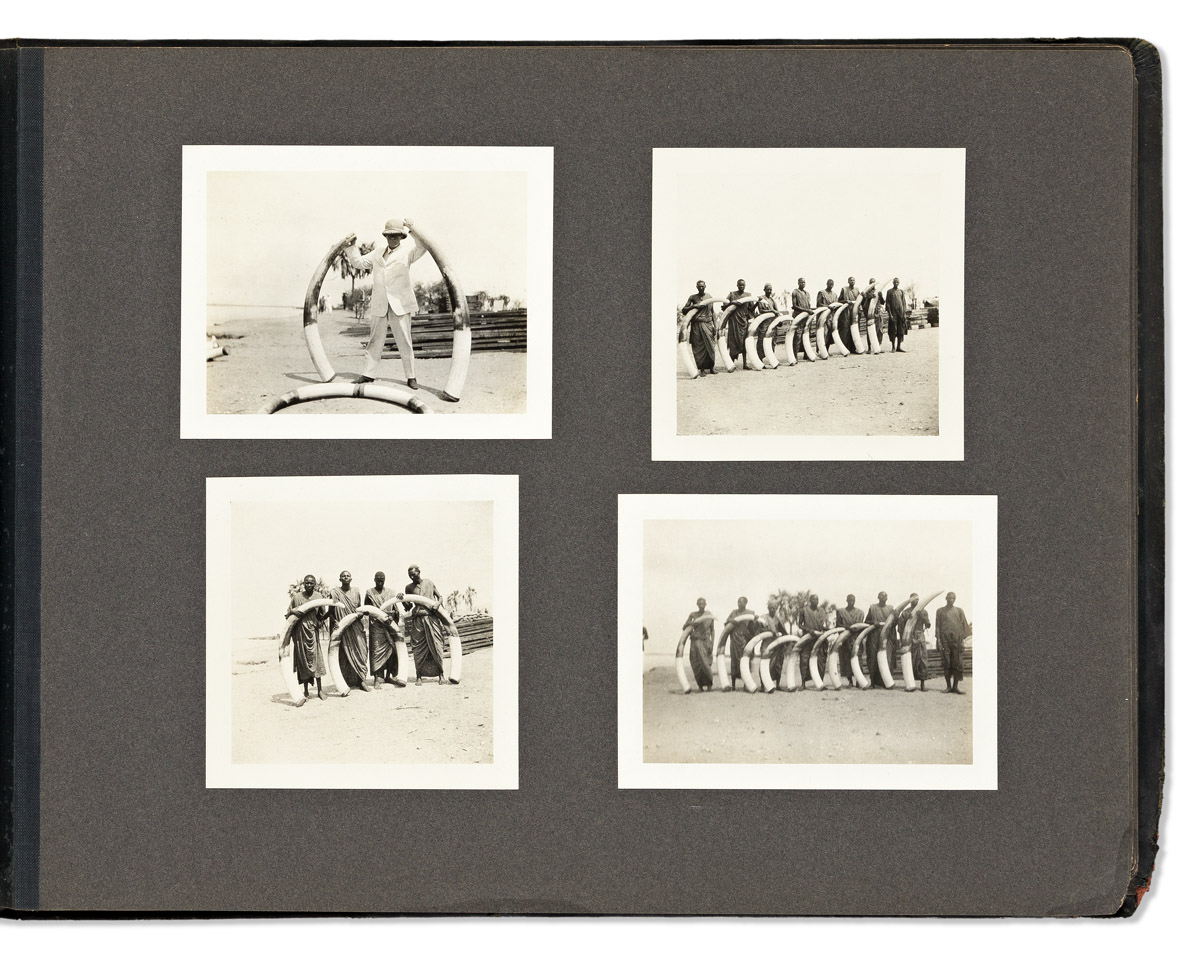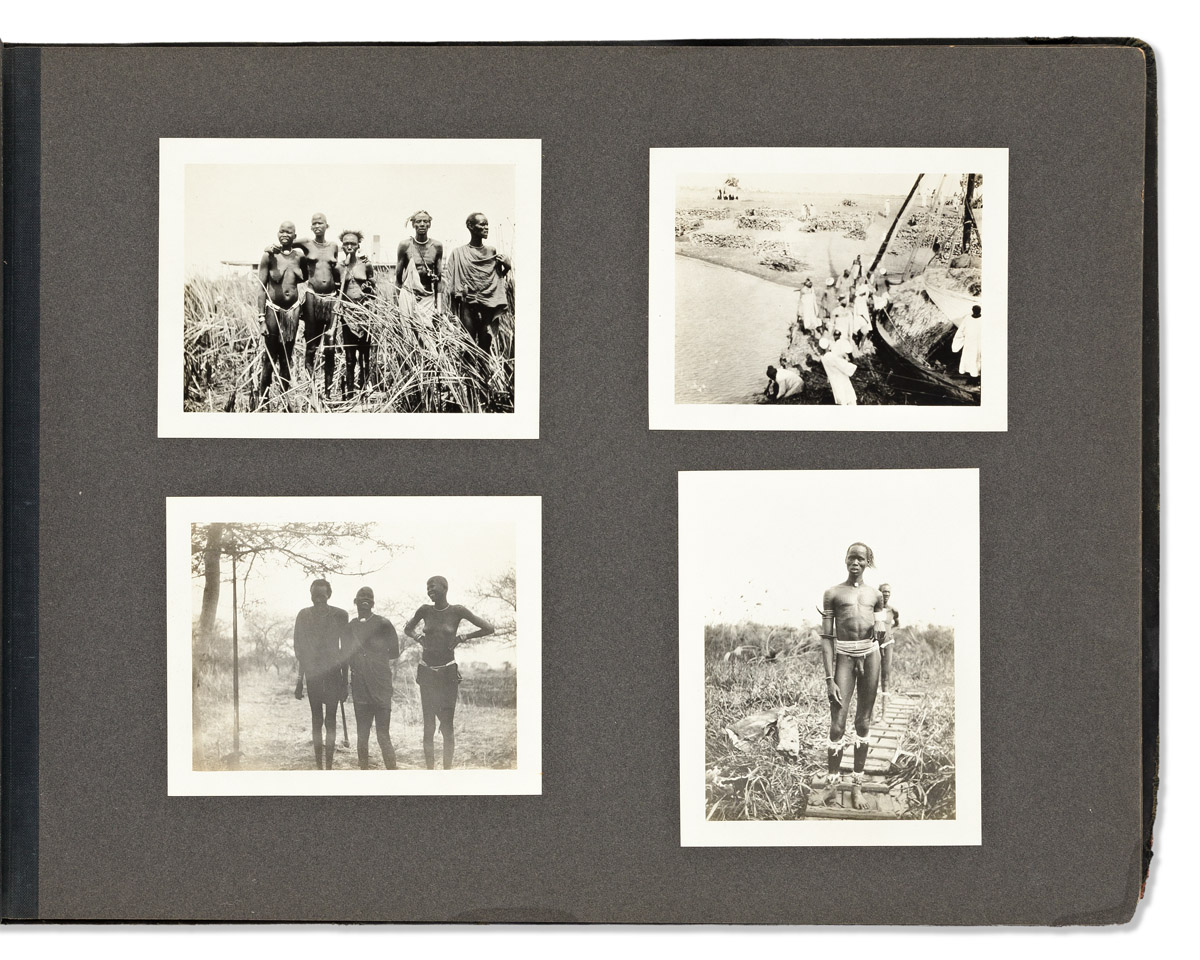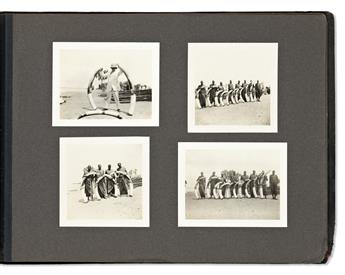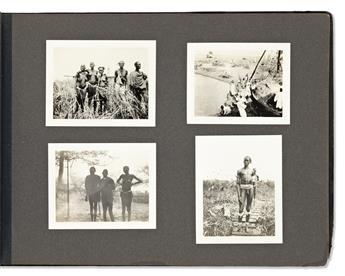Sale 2624 - Lot 211
Price Realized: $ 850
Price Realized: $ 1,062
?Final Price Realized includes Buyer’s Premium added to Hammer Price
Estimate: $ 800 - $ 1,200
(PHOTOGRAPHY -- AFRICAN SAFARI.) Photographs Taken on a Big Game Hunt in the Soudan. Photographic title, map, and 114 albumen prints. Mostly 3 1/2x4 1/2 inches, mounted to album cards; gilt-blocked black calf portfolio, light wear; minor chipping to mounts, photographs fine. Np, 1914
Additional Details
Evocative catalog of early 20th-century African shooting exploitations by three "great white hunters" from New York, Henry Pomeroy Davison, John H. Prentice, and Daniel E. Pomeroy, on their month and a half long big game chase in Sudan along the White Nile River between Khartoum and Bor. The excursion was not solely for sport - the men were also there to take trophy specimens for the American Museum of Natural History, for which Davison served as treasurer. For their own recreation, and institutional posterity, the venture appears to have been quite successful.
About half the images are ethnographic, illustrating local landscapes, villages, people and customs; the other half display the trio's conquests: crocodile, buffalo, antelope, hippopotamus, rhino, and elephant.
This trip is described in detail in Thomas W. Lamont's "Henry P. Davison, The Record of a Useful Life", 1933, pages 251-259; 334-367. A few excerpts here, for which the present collection of photographs serve as stark amplification:
"About 10 I decided to go out for hippo. At 11 I had a shot at one and missed him. In a few moments I had a shot at another as he raised his massive head to the surface of the water. As my bullet made no splash I knew I had hit him. He of course went down and there was nothing to do but await developments. True to the nature of the beast, he showed his back on the surface of the water just three hours later. We went out and towed him to shore. Such a beast, a monster. The natives, Dinkas, hovered about him like the ravishing dogs they are; and when the word was given, in they jumped with their knives and soon made the place look like a slaughter-house all fighting over each piece of meat and bone, the women standing by to divide the spoils. They welcome a shooting-party and gladly point out the game as it means meat to them".
"One evening Harry wounded a fair-sized bull elephant, and next morning he and I, with two gun bearers apiece, started out to look for him. We saw no trace of the wounded bull, and Harry seemed very much disappointed, more so, I think, than I ever saw him. I climbed to the top of a big ant hill, looked over all the country with my glasses, and saw about two miles away, a huge, solitary, bull elephant. Even at that distance, I could see he had wonderful ivory. I told this to Harry and he was as pleased as a boy, for it was his shot. We went up to the elephant which was standing in a sort of marsh. As we approached him, he began to move off at right angles to us. Harry shot him four times, and seemed to be hurting him. He was then about a hundred yards off. Much to our surprise, he turned like a polo pony and came right at us on a gallop. His trunk and tusks were held high in the air, and it was the most handsome sight, as Harry said, either of us had ever seen. There was not even a bush between us and him, and the only thing to do was to kill him or turn him. Harry and I each gave him two barrels in the head, and did not reach his brain. But he did not seem to care for it, and he turned and moved off slowly. We followed him up, and after a few more shots he went down. I have never in my life seen a more delighted man than Harry Davison was when he saw what a wonderful trophy he had. The tusks, which weighed eighty-five pounds apiece, are now in his house at Peacock Point, and I think that there are few larger outside of museums".
"In going up to the bodies of the three dead rhino, to our utter amazement and chagrin, we found that we had killed three white "square-nosed" rhino. They are protected. We had permission to shoot one for the American Museum of Natural History, but to kill three, even by accident so to speak, was indeed bad news. I was worried about the rhino and suggested taking them out by the Belgian Congo, as they were fine specimens. Harry said : "Don't give it a thought, but let me do the talking when we get back to Khartum." When we arrived at Khartum, Harry arranged the whole matter in half an hour with Sir Reginald Wingate, Sirdar of the Sudan. The big rhino was to be mounted whole for the American Museum, and Harry and I, by paying £100 apiece, took the other two heads as museum specimens".
About half the images are ethnographic, illustrating local landscapes, villages, people and customs; the other half display the trio's conquests: crocodile, buffalo, antelope, hippopotamus, rhino, and elephant.
This trip is described in detail in Thomas W. Lamont's "Henry P. Davison, The Record of a Useful Life", 1933, pages 251-259; 334-367. A few excerpts here, for which the present collection of photographs serve as stark amplification:
"About 10 I decided to go out for hippo. At 11 I had a shot at one and missed him. In a few moments I had a shot at another as he raised his massive head to the surface of the water. As my bullet made no splash I knew I had hit him. He of course went down and there was nothing to do but await developments. True to the nature of the beast, he showed his back on the surface of the water just three hours later. We went out and towed him to shore. Such a beast, a monster. The natives, Dinkas, hovered about him like the ravishing dogs they are; and when the word was given, in they jumped with their knives and soon made the place look like a slaughter-house all fighting over each piece of meat and bone, the women standing by to divide the spoils. They welcome a shooting-party and gladly point out the game as it means meat to them".
"One evening Harry wounded a fair-sized bull elephant, and next morning he and I, with two gun bearers apiece, started out to look for him. We saw no trace of the wounded bull, and Harry seemed very much disappointed, more so, I think, than I ever saw him. I climbed to the top of a big ant hill, looked over all the country with my glasses, and saw about two miles away, a huge, solitary, bull elephant. Even at that distance, I could see he had wonderful ivory. I told this to Harry and he was as pleased as a boy, for it was his shot. We went up to the elephant which was standing in a sort of marsh. As we approached him, he began to move off at right angles to us. Harry shot him four times, and seemed to be hurting him. He was then about a hundred yards off. Much to our surprise, he turned like a polo pony and came right at us on a gallop. His trunk and tusks were held high in the air, and it was the most handsome sight, as Harry said, either of us had ever seen. There was not even a bush between us and him, and the only thing to do was to kill him or turn him. Harry and I each gave him two barrels in the head, and did not reach his brain. But he did not seem to care for it, and he turned and moved off slowly. We followed him up, and after a few more shots he went down. I have never in my life seen a more delighted man than Harry Davison was when he saw what a wonderful trophy he had. The tusks, which weighed eighty-five pounds apiece, are now in his house at Peacock Point, and I think that there are few larger outside of museums".
"In going up to the bodies of the three dead rhino, to our utter amazement and chagrin, we found that we had killed three white "square-nosed" rhino. They are protected. We had permission to shoot one for the American Museum of Natural History, but to kill three, even by accident so to speak, was indeed bad news. I was worried about the rhino and suggested taking them out by the Belgian Congo, as they were fine specimens. Harry said : "Don't give it a thought, but let me do the talking when we get back to Khartum." When we arrived at Khartum, Harry arranged the whole matter in half an hour with Sir Reginald Wingate, Sirdar of the Sudan. The big rhino was to be mounted whole for the American Museum, and Harry and I, by paying £100 apiece, took the other two heads as museum specimens".
Exhibition Hours
Exhibition Hours
Aliquam vulputate ornare congue. Vestibulum maximus, libero in placerat faucibus, risus nisl molestie massa, ut maximus metus lectus vel lorem.








